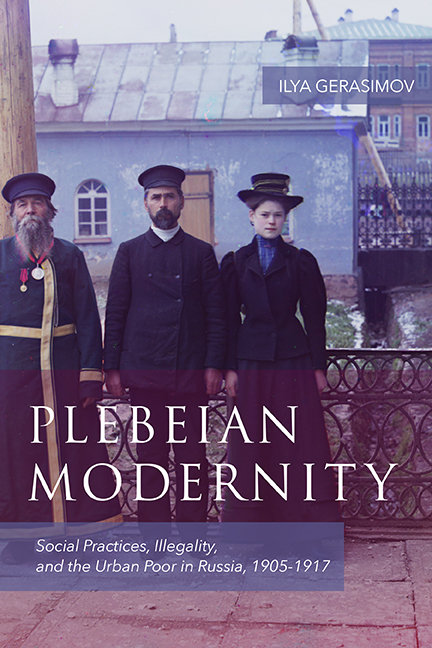Book contents
- Frontmatter
- Contents
- Acknowledgments
- Note on Editorial Conventions
- Introduction: The Subalterns Speak Out: Gerasim and the Infamous
- 1 Writing Degree Zero, and Beyond: Reading Social Practices between the Lines
- 2 The Middle Volga City as the Middle Ground: Urban Plebeian Society
- 3 The Patriarchal Metropolis: Trespassing Social Barriers in Late Imperial Vilna
- 4 “We Only Kill Each Other”: The Anthropology of Deadly Violence and Contested Intergroup Boundaries
- 5 The Transformative Social Experience of Illegality
- Epilogue: Gerasim in Power: A Plebeian Modernity
- Notes
- Selected Bibliography
- Index
3 - The Patriarchal Metropolis: Trespassing Social Barriers in Late Imperial Vilna
Published online by Cambridge University Press: 09 June 2021
- Frontmatter
- Contents
- Acknowledgments
- Note on Editorial Conventions
- Introduction: The Subalterns Speak Out: Gerasim and the Infamous
- 1 Writing Degree Zero, and Beyond: Reading Social Practices between the Lines
- 2 The Middle Volga City as the Middle Ground: Urban Plebeian Society
- 3 The Patriarchal Metropolis: Trespassing Social Barriers in Late Imperial Vilna
- 4 “We Only Kill Each Other”: The Anthropology of Deadly Violence and Contested Intergroup Boundaries
- 5 The Transformative Social Experience of Illegality
- Epilogue: Gerasim in Power: A Plebeian Modernity
- Notes
- Selected Bibliography
- Index
Summary
Vilna: Two Portraits of the City
It was one o’clock in the morning on Friday, July 5, 1913, when the chief of police of Vilna, Lt. Col. Fedor Deminskii stepped out of the city police headquarters on Blagoveshchenskaia Street (now Dominikonų gatvė). He strolled one block along the street, and turned right to Ignat’evskii Lane (Stiklių gatvė today). Over the next three hours, accompanied by his aides, he walked through the streets of downtown to the railroad station and back, meticulously registering any violations of official regulations and public order. Overall, he noticed fifteen wrongdoings. Just across the street from his office, the main entrance to a building was not locked for the night, nor were two other buildings along the way. The janitor (dvornik) of another building was found asleep (resolution: a fine of 2 rubles or arrest for one day); his colleague a few blocks away did not have a whistle (resolution: a fine of 1 ruble or arrest). In the American hotel, one of the rooms was occupied by a carpenter, who also worked there (resolution: to prohibit this in the future). Prostitutes were discovered at a refreshment shop that sells drinks, and its courtyard was found to be unsanitary (resolution: to write up a police report), while in the Gentry Club there was a wedding with orchestra (“I do not have information about this event. Why was it not reported to me?”).
For a bustling city of two hundred thousand inhabitants, in the early twentieth century, these transgressions strike one as incredibly innocent, and the fact that they deserved the attention of the city chief of police is puzzling. In the wake of the 1905 Revolution and in the context of modernization of all branches of government service, the figure of the Polizeimeister personally inspecting the city at night on a weekly basis seems a ghost of the good old days of direct patriarchal authority, unmediated by bureaucratic machinery and legal procedures. Chiefs of police in other urban centers of the Russian Empire could also personally intervene in the everyday lives of inhabitants of their cities, but they did not walk the streets at night on a weekly basis, and their resolutions did not have the effect of direct patriarchal rule.
- Type
- Chapter
- Information
- Plebeian ModernitySocial Practices, Illegality, and the Urban Poor in Russia, 1906–1916, pp. 81 - 107Publisher: Boydell & BrewerPrint publication year: 2018

